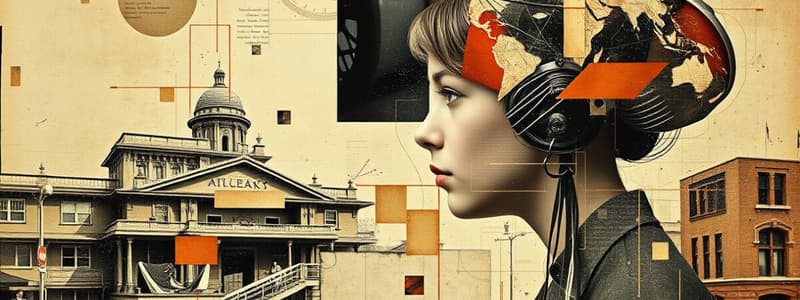Podcast
Questions and Answers
What is the digital age defined as?
What is the digital age defined as?
The time period starting in the 1970s with the introduction of the personal computer and subsequent technology allowing for the transfer of information freely and quickly.
Which of the following best defines communication?
Which of the following best defines communication?
- A technique for public speaking.
- A method for sending letters.
- A way to write books.
- A process of exchanging information and ideas. (correct)
What does the term 'encoding' refer to in the communication process?
What does the term 'encoding' refer to in the communication process?
The process of conversion of subject matter into symbols.
Feedback is an irrelevant component of the communication process.
Feedback is an irrelevant component of the communication process.
Which of the following is NOT a component of the communication process?
Which of the following is NOT a component of the communication process?
Nonverbal communication is sometimes referred to as ______.
Nonverbal communication is sometimes referred to as ______.
What is metacommunication?
What is metacommunication?
The digital age began in the 1970s with the introduction of the personal computer.
The digital age began in the 1970s with the introduction of the personal computer.
Communication is solely about verbal messages and excludes nonverbal messages.
Communication is solely about verbal messages and excludes nonverbal messages.
The context of communication does not influence the meaning of the message.
The context of communication does not influence the meaning of the message.
Encoding refers to the process of converting subject matter into symbols.
Encoding refers to the process of converting subject matter into symbols.
The main objective of a message must be unclear to be effective.
The main objective of a message must be unclear to be effective.
A sender is the person who receives the message in the communication process.
A sender is the person who receives the message in the communication process.
Communication modifies the disposition of both parties involved in the exchange.
Communication modifies the disposition of both parties involved in the exchange.
Digital communication is limited to emails and does not include other forms like social media.
Digital communication is limited to emails and does not include other forms like social media.
Intrapersonal communication involves communication with a large group of people.
Intrapersonal communication involves communication with a large group of people.
Psychological barriers to communication exist only in the minds of the speakers.
Psychological barriers to communication exist only in the minds of the speakers.
Mass communication utilizes social media platforms for effective outreach.
Mass communication utilizes social media platforms for effective outreach.
Medium is a means used to exchange or transmit the message.
Medium is a means used to exchange or transmit the message.
Dyadic communication takes place between three people.
Dyadic communication takes place between three people.
Decoding is the process of creating an encoded message.
Decoding is the process of creating an encoded message.
Organizational barriers arise from unclear duties and lines of authority.
Organizational barriers arise from unclear duties and lines of authority.
Verbal communication includes both spoken and written words.
Verbal communication includes both spoken and written words.
Effective communication is influenced by the 'Seven C's' principle.
Effective communication is influenced by the 'Seven C's' principle.
Feedback can only be verbal and cannot take written form.
Feedback can only be verbal and cannot take written form.
Physical barriers to communication can be perceived using one or more of the senses.
Physical barriers to communication can be perceived using one or more of the senses.
Nonverbal communication does not involve gestures or facial expressions.
Nonverbal communication does not involve gestures or facial expressions.
Symbolic communication can include forms like art and music.
Symbolic communication can include forms like art and music.
Interpersonal communication occurs at a level involving just one person.
Interpersonal communication occurs at a level involving just one person.
Metacommunication refers to communication about communication.
Metacommunication refers to communication about communication.
Pacing is an irrelevant aspect of verbal communication.
Pacing is an irrelevant aspect of verbal communication.
Mechanical barriers can include non availability of proper machines and power failure.
Mechanical barriers can include non availability of proper machines and power failure.
The gestural mode is primarily concerned with the written representation of ideas.
The gestural mode is primarily concerned with the written representation of ideas.
Perceptional barriers can arise from a lack of common experiences and different linguistic backgrounds.
Perceptional barriers can arise from a lack of common experiences and different linguistic backgrounds.
Aural communication relies solely on visual aspects to convey meaning.
Aural communication relies solely on visual aspects to convey meaning.
Multimodal texts integrate various communication modes such as linguistic, visual, gestural, audio, and spatial.
Multimodal texts integrate various communication modes such as linguistic, visual, gestural, audio, and spatial.
Physical health can be classified as a perceptional barrier to communication.
Physical health can be classified as a perceptional barrier to communication.
The visual mode depends on auditory signals for its interpretation.
The visual mode depends on auditory signals for its interpretation.
Interrupting the speaker can be a form of perceptional barrier from the receiver's side.
Interrupting the speaker can be a form of perceptional barrier from the receiver's side.
Flashcards are hidden until you start studying
Study Notes
Learning Outcomes
- Understand various modes of communication and their role in enhancing message meaning.
- Critically analyze multimodal texts to evaluate factual information.
Digital Age Defined
- The digital age, or information age, began in the 1970s with the personal computer's introduction.
- Characterized by rapid information transfer facilitated by technology, including the Internet and email.
Communication Defined
- Derived from the Latin word "communis," meaning common; involves the exchange of facts, ideas, and opinions.
- Viewed as a process of sharing experiences, leading to mutual understanding (John Dewey).
- Functions as a persuasive tool for influencing others (Aristotle).
Communication Process
- Involves the exchange of verbal and non-verbal messages, representing a continuous exchange.
Main Components of Communication Process
- Context: Influences communication; can be physical, social, chronological, or cultural.
- Sender/Encoder: The individual who sends the message using symbols like words or visuals.
- Message: Key idea intended for communication; clarity of the objective is crucial.
- Encoding: The conversion of abstract subject matter into symbols for transmission.
- Medium: The method used to convey the message (written or oral).
- Recipient/Decoder: The target of the message; understanding varies based on their knowledge and receptiveness.
- Decoding: The translation of encoded messages into understandable language.
- Feedback: Critical for assessing the message's effectiveness; can be verbal, non-verbal, or written.
Types of Communication
-
Verbal Communication: Use of words in spoken or written form; important aspects include:
- Language, pacing, intonation, clarity and brevity, timing, and relevance.
-
Nonverbal Communication: Exchange through body language, including:
- Gestures, facial expressions, posture, gait, body space, touch, personal appearance, eye contact, sounds, and silence.
-
Symbolic Communication: Utilizes verbal and nonverbal symbols to convey meaning; includes art and music for understanding and healing.
-
Metacommunication: Refers to communication about communication, aiding in the understanding of deeper meanings within messages.
Communication in the Digital Age
-
Course Learning Outcomes:
- Understand modes of communication and their combination for enhanced message meaning.
- Critically analyze multimodal texts for factual accuracy.
-
Digital Age Definition:
- Initiated in the 1970s with personal computer introduction.
- Characterized by free and rapid information transfer via the Internet and email.
Communication Overview
- Definition of Communication:
- Derived from the Latin "communis," meaning common.
- Involves exchange of facts, ideas, and opinions for mutual understanding.
- Influences the disposition of both sender and receiver.
Communication Process Components
- Main Components:
- Context: Affects communication based on physical, social, chronological, or cultural factors.
- Sender/Encoder: The person sending the message, using symbols for communication.
- Message: Key idea intended for communication; clarity is essential.
- Encoding: Conversion of abstract subject matter into recognizable symbols.
- Medium: Method used for message transmission (e.g., written vs. oral).
- Recipient/Decoder: The target of the message whose understanding varies by knowledge and responsiveness.
- Decoding: Translation of encoded messages into understandable language.
- Feedback: Essential for assessing message efficacy, can be verbal or non-verbal.
Types of Communication
-
Verbal Communication: Exchange using spoken or written words focusing on language, clarity, pacing, and timing.
-
Nonverbal Communication: Includes body language, gestures, facial expressions, and posture. Elements include eye contact, personal space, and touch.
-
Symbolic Communication: Conveys meaning through various forms, like art and music, aiding understanding.
-
Metacommunication: Communication about communication, revealing deeper meanings beyond the surface message.
-
Written Communication: Ideal for long-distance information exchange and clarity when oral communication isn't feasible.
Forms of Communication
-
Intrapersonal Communication: Internal dialogue involving self-reflection and processing of messages.
-
Interpersonal Communication: Interaction among small groups. Includes:
- Dyadic: Communication between two individuals.
- Tryadic: Involvement of three participants.
- Small Group: Interaction among larger groups for problem-solving.
-
Mass/Public Communication: Reaches large audiences through mass media, e.g., speeches, television, and newspapers.
Barriers to Communication
-
Organizational Barriers: Arise from unclear duties, policies, facilities, or organizational complexity.
-
Psychological Barriers: Internal factors like poor pronunciation, confusion, anxiety, and unfavorable attitudes affecting communication.
-
Physical Barriers: External noise or disruptions that impede message transmission (e.g., loud sirens, phone ringing).
-
Mechanical Barriers: Issues with technology or communication tools, including equipment malfunctions and poor connectivity.
-
Perceptual Barriers: Differences in experiences and language proficiency that hinder understanding.
Multimodal Texts
- Characterization: Combine five modes of communication: linguistic, visual, gestural, audio, spatial.
Modes of Communication
-
Visual Mode: Utilizes images and symbols to convey meanings (e.g., traffic signs).
-
Aural Mode: Focuses on sound elements like tone of voice, volume, and auditory effects (e.g., recorded speeches).
-
Gestural Mode: Interprets movements, including facial expressions and body language, enhancing communication depth.
-
Linguistic (Alphabetic) Mode: Involves written or spoken words, critical for effective information conveyance.
Studying That Suits You
Use AI to generate personalized quizzes and flashcards to suit your learning preferences.




